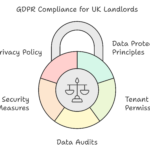Many landlords have thought renting to families means more damage and trouble. But, research shows that the right families can be great tenants. With more families looking for rentals and new government plans, now is a good time to consider this market. By knowing the market, getting your property ready, and setting the right rules, you can reduce risks and gain from renting to families with kids.
Key Takeaways
- Families are a big part of the private rented sector, offering a chance for landlords to make more money.
- Choosing the right family tenants can mean longer stays and fewer repair issues.
- Changing your property to welcome families can draw in quality tenants for the long haul.
- It’s key to know and follow laws against discrimination when renting to families.
- Allowing pets can also help you attract more family tenants.
Understanding the Market for Family Tenants
For landlords, knowing the family tenant market is key to success. Recent data shows interesting facts that can help your strategy. Over 50% of the UK owns a pet, but only 7% of landlords say their homes allow pets. This shows a big chance for landlords who welcome pets.
Between 2017-18, 35% of private rented homes had kids, and in 2019, half of new babies lived in rented places. Surveys show that families and pet owners are great tenants. They often stay longer to keep their children and pets happy.
Factual Data on Family Tenants
The government has brought in rules to help families rent homes. These include a new tenancy agreement for families and laws to protect tenants if landlords face mortgage issues.
The Tenant Fees Act of 2019 limits some costs for tenants. Landlords should have clear tenancy agreements. These should include rent details, payment times, pet rules, and an inventory to avoid arguments.
| Key Statistic | Value |
|---|---|
| Percentage of UK population owning a pet | 50% |
| Percentage of landlords advertising pet-friendly homes | 7% |
| Percentage of households in the private rented sector with dependent children (2017-18) | 35% |
| Percentage of new babies born into rented accommodation (2019) | 50% |
Understanding these trends and laws helps landlords attract more family and pet-friendly renters. This can lead to long-term, stable tenants.

Preparing Your Property for Family Tenants
When renting to families with children, it’s key to make sure your property is ready. You should upgrade and modify it to be safe and welcoming. This makes it appealing to family tenants.
Having enough parking is a must for families. Make sure your property has easy parking access, either on-site or nearby. This is important for families who need to move kids and stuff around.
The kitchen is also crucial. Make sure it has a full-size dishwasher, a big fridge-freezer, and a large washing machine. These features help families with kids manage daily tasks. A strong oven, hob, and extractor fan are also good for families who like cooking at home.
- Durable, washable paint on the walls
- Sturdy fittings and fixtures, such as handles, locks, and taps
- Hardwood floors in living areas and bedrooms, and tiles in bathrooms and kitchens
- Ample storage space for families’ belongings
- Allowing tenants to decorate their children’s rooms to create a sense of home
Don’t forget the outdoor space. A lawned garden with strong fencing is great for kids to play safely. These features, along with your careful attention, will make your property stand out to families.

Child Safety Measures
Proactive Safety Considerations
When renting to families with kids, think about how to prevent accidents. As a landlord, you must keep your tenants, especially kids, safe and sound.
First, check your property for safety issues. Make sure stair banisters are close enough together, and fit window restrictors on upstairs windows. Ask your tenants to use safety gear like wall pads for baby gates and cord cleats.
Offering these tips shows you care about safety measures for rentals and your responsibilities for child safety. It builds trust with your tenants. They’ll see you’re serious about proactive safety features for families and stopping child accidents in rental properties.
- Ensure stair banisters are no more than 10cm apart
- Install window restrictors on upstairs windows
- Suggest protective wall pads for baby gates
- Recommend drill-free child-proof catches on low kitchen cupboards
- Provide cleats to wrap cords for blinds or curtains
By doing these things, you show you’re serious about child safety in rentals. This makes a safe place for families with kids. It also helps build a good landlord-tenant relationship.
Tips for landlords renting to families with children
When you rent to families with kids, make sure your property is safe and welcoming. It’s important to have clear rules and paperwork from the start. As a landlord, you have certain duties to families with kids. By acting early, you can reduce risks and create a strong bond with your tenants.
Make sure your tenancy agreement clearly states that the property must be returned as it was. This means fixing any damage from pets or kids and restoring the decoration. Add a rule that all pet smells must be removed with professional help or cleaning. Also, ask your tenants to sign a detailed inventory of the property, with photos of everything. This can stop arguments when the tenancy ends.
For safety, landlords renting to families with kids should think about these steps:
- Securing windows to prevent climbing accidents
- Using safety glass on doors to avoid injuries
- Ensuring blinds comply with safety laws to prevent strangulation hazards
- Securing televisions to prevent them from toppling over
- Maintaining tight banister spindles to avoid falls
- Addressing any outdoor hazards, such as unfenced pools or uneven surfaces
These steps can make your property safer for your tenants and lower your risk of being sued. Adding safety rules to your tenancy agreement is also a good idea. It makes your expectations and duties as a landlord clear.
Renting to families with kids can be rewarding but needs extra care. Focus on safety, clear communication, and protecting your property. This way, you can build a positive relationship with your tenants and make renting smooth for everyone.
Vetting and Accepting Pet-Owning Tenants
Many landlords worry about renting to pet owners, fearing damage or disruption. But, a detailed pet screening process can ease these worries. It can lead to finding responsible pet owners. Ask for a ‘pet CV’ from potential tenants, including the pet’s age, breed, and health details.
Also, check the tenant’s past landlord for pet-related info. Meeting the pet in person or via video helps understand its character. Ask about the pet’s social life, especially for dogs that may get anxious alone.
Pets can make homes more welcoming. A thorough screening process helps landlords trust pet owners. This way, you can offer a pet-friendly rental experience.
Pet Screening Process
Here are steps for a successful pet-friendly rental:
- Ask for a ‘pet CV’ with details on the animal’s health and behaviour.
- Include pet questions in the tenant’s reference check.
- Meet the pet to gauge its temperament.
- Ask about the pet’s social life, especially for dogs.
- Make sure the tenant agrees to your pet policies.
By carefully checking potential pet owners, you can create a welcoming space. This benefits both landlords and tenants.
| Statistic | Value |
|---|---|
| Percentage of the UK population that owns a pet | 50% |
| Percentage of landlords that advertise their homes as pet-friendly | 7% |
| Percentage of households in the private rented sector that included dependent children (2017-18) | 35% |
| Percentage of new babies born into rented accommodation (2019) | 50% |
| Percentage of landlords who said adults caused more damage compared to pets (survey of 537 landlords) | 85% |
| Percentage of landlords who said pets caused more damage compared to adults (survey of 537 landlords) | 84% |
| Percentage of landlords who said children caused more damage compared to adults and pets (survey of 537 landlords) | 54% |
| Percentage of millennials predicted to remain as tenants for their whole lives | 33% |
These figures show the UK’s growing need for pet-friendly rentals. By carefully screening pet owners, landlords can balance tenant rights with property protection. This creates a welcoming space for pets and their owners.
Conclusion
Renting to families with children can be rewarding for landlords who prepare well and have the right policies. By understanding the demand for family-friendly rentals, making your property safe for kids, and checking on pet owners, you can reduce risks. This approach helps build strong, lasting relationships with your tenants.
For landlords, being proactive, clear in communication, and open to family needs is key. With the right strategies, you can attract reliable, long-term tenants. This also helps keep your property’s value high.
When renting to families with children, focus on making your property safe, comfy, and welcoming. Follow the tips in this article to make your rental stand out. This way, you can create strong bonds with your tenants.




